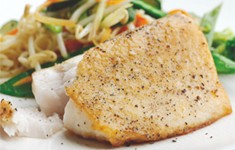 ars the production of cobia (Rachycentron canadum), a fast-growing tropical marine species, has been expected to take off, but farmers in Asia have been switching to other finfish such as pompano.
ars the production of cobia (Rachycentron canadum), a fast-growing tropical marine species, has been expected to take off, but farmers in Asia have been switching to other finfish such as pompano.A Taiwanese research paper suggested there was the potential to farm one million metric tons (MT) of cobia annually worldwide. However, according to a senior figure in the cobia farming industry, production peaked in 2006-2007 at 20,00 to 30,000 MT.
Production has since plummeted and in 2012 it was thought to have been less than 5,000 MT worldwide, perhaps even half that figure, so a near 90 percent reduction from its peak.
Marine Farms ASA, a Norwegian aquaculture specialist, invested more than USD 10 million (EUR 7.79 million) in developing a cobia farming operation in Vietnam and started to harvest the white-fleshed fish there in 2006-2007.
It was said to be the world’s largest cobia farm with the potential to produce 5,000 MT. However, production peaked at 1,200 MT in 2010 then steadily declined. The actual harvest of cobia last year was 335 MT, although Marine Farms Vietnam also produced 700 MT of pompano.
The original intention had been to produce fish for the European and U.S. markets, and frozen farmed cobia fillet portions and loins were introduced at the European Seafood Exposition in 2010. Reaction was said to have been favorable and product was subsequently stocked by various distributors.
However, despite the introduction of value-added cobia products in Europe, sales there didn’t fulfill expectations and Jorge Alarcon, managing director of Marine Farms Vietnam, has changed the marketing strategy.
In 2012, the bulk of the cobia produced in Vietnam was sold fresh ex-farm to the local market, with a small amount of fresh fish exported to Australia, and some frozen products sent to Taiwan, Japan, and Korea. A very small amount of fresh cobia was exported to Europe.
The ownership of the cobia operation is currently in transition. Morpol, which bought Marine Farms in September 2010, agreed to a takeover approach by Marine Harvest earlier this year. Once the sale is approved, the Marine Farms’ cobia operation — which includes Marine Farms Belize set up to supply the U.S. market but is currently not producing fish — will be purchased by Jerzy Malek, Morpol’s founder.
Not surprisingly, therefore, Marine Farms Vietnam’s stocking plans for 2013 have been reduced until the new ownership structure is in place.
It is not just in Vietnam where cobia production was scaled down. Most of the farmers producing cobia in the 2000s gave up at the end of that decade because it wasn’t profitable. Alarcon believes that the then oversupply of cobia depressed the selling price too far to make it commercially viable to produce.
“Cobia is an expensive fish to farm and the large sizes reared at that time were never economically viable,” he said.
Alarcon believes the reason that cobia sales in Europe have been poor is that it is an unknown species competing in a diverse market with plenty of cheaper fish available. Cobia certainly is never going to compete on price with the likes of pangasius, tilapia, or Alaska pollock.
“It is a premium product that deserves a better price,” he said. “I guess it all goes back to educating consumers about its qualities and properties.
“I think cobia production will cycle into larger volumes in the coming years as the limited supply in the last couple of years has increased its price and attracted some producers to stock some juveniles again. Similarly I think the production of pompano, to which many cobia farmers switched, will drop some given current prices.”
It remains to be seen what Malek will do with the Vietnam and Belize operations after he takes them over. In the meantime, Alarcon is concentrating cobia sales in local and domestic markets.
“We can get a better return by selling fresh in these markets. Also because the fish are known, people are willing to pay a better price for a quality fish.”





